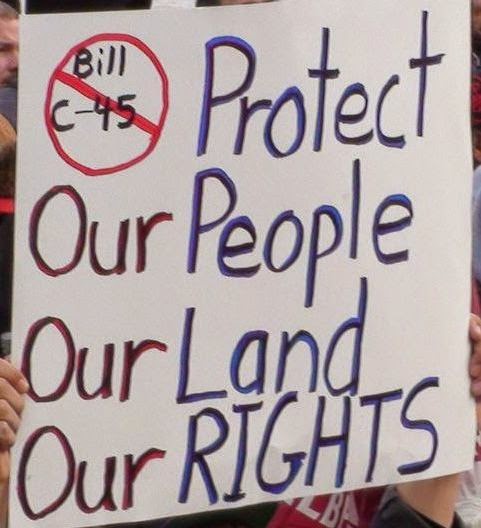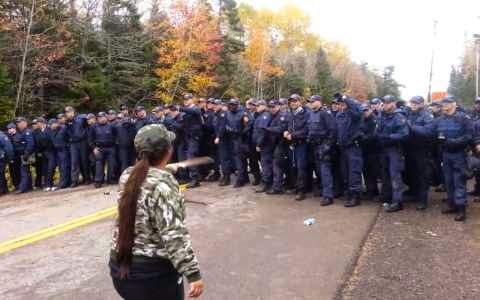In 2014, the RCMP released a report on their “National Operational Review” on the issue of “Missing and Murdered Aboriginal Women” which amounted to 1181 women total – 164 missing and 1017 murdered. The core conclusion of the report was that “Aboriginal women”* were over-represented in the numbers of murdered and missing. They cautioned readers that their report contained a certain amount of “error and imprecision” given the thirty year period of review, the human error of investigators, inconsistency of collection, and definitional issues.
Let’s look at that caveat a little closer. The RCMP had to “limit” their file review to missing women who had been identified by RCMP on CPIC (Canadian Police Information Centre) as “non-white” female or “blank”. The category of “Aboriginal origin” was only recently added to CPIC and so could not possibly capture all Aboriginal persons. Similarly, the numbers do not include Aboriginal women who were mistakenly recorded as “white” or Aboriginal women who were reported missing but were never recorded. Given the high level of overt and systemic racism in policing as confirmed in the Donald Marshall Jr., Manitoba Justice, Ipperwash, and Pickton inquiries, the numbers of those missing never recorded could be extremely high.
Now, let’s look at how the RCMP or other jurisdictions determine who is “Aboriginal”. The RCMP report notes that they used “perception-based assessment”. In other words, “how a police officer defines how an individual looks in terms of complexion and/or ancestry”. However, even this determination is not consistent across jurisdictions. Any number of jurisdictions use the following to identify persons:
(1) official Aboriginal “status”;
(2) officer discretion; and
(3) self-identification.
Based on the above, it would seem logical that the RCMP would miss identifying a large portion or even majority of Aboriginal persons. In the first methodology, I presume they meant to say “Indian status” or “Indian registration” because there is no formal or official “Aboriginal status”. I hope the RCMP know at least this much about the legislated identity of Indigenous peoples in Canada (hint: it’s in the Indian Act). For those that only use “Indian status”, that would exclude all the non-status Indians, Métis, and Inuit individuals in Canada. The most recent National Household Survey indicated that there were 1,400,685 Aboriginal people in Canada and only 637,660 of them were registered Indians. That leaves 763,025 individuals (more than half the Aboriginal population) excluded from possible identification as Aboriginal by RCMP standards.
Even those who are identified based on their official Indian status, the RCMP fails to take into consideration the fact that there are well over 20,000 people with Indian status who do not descend from nor identify as “Indian” or “Aboriginal”. This is thanks again to the Indian Act which made non-Indian women and their non-Indian male and female children registered as Indians, despite their lack of Aboriginal ancestry or cultural connection. This equates to thousands of men with Indian status that are not in fact Aboriginal.
With regards to the second methodology, the RCMP are identifying Aboriginal peoples based on a racist set of biological and/or physical characteristics which they unilaterally assign to Aboriginal people. In other words, “Aboriginal people” are treated as one race of people with certain pre-determined physical characteristics – like hair, eye or skin colour. They ignore the fact that Indigeneity is social, cultural, political, legal, territorial, and nation-based – not an identity based on race. This racist methodology would be as useless as trying to identify a Canadian citizen gone missing in the USA based on skin colour. Clearly, the RCMP would miss the vast majority of “Aboriginal people” using this kind of methodology.
With regard to the third methodology of self-identification, the RCMP failed to indicate what percentage of jurisdictions actually rely on self-identification. This of course would not work in the context of a murdered or missing Aboriginal woman as she cannot self-identify. It might only work in the context of the woman’s family or friends choosing to identify her as Aboriginal. It is impossible to know how many people would voluntarily self-identify given the extent to which every level of the justice system is infected with overt and systemic racism as per the numerous justice inquiries. Many Aboriginal people have a justified fear of the RCMP stemming from residential school days, Starlight tours, and deaths in police custody – as well as provincial police forces for similar reasons.
So, it is logical to conclude that the RCMP grossly under-counted the actual numbers of murdered and missing Aboriginal women in Canada. This conclusion is confirmed by the RCMP’s own admission that due to these methodological problems “a high number of Homicide survey reports where the identity of the victim (and/or accused) remained unknown“. This admission on their part is extremely important in understanding the racist dialogue which has recently unfolded at the Ministerial level.
Aboriginal Affairs Minister Bernard Valcourt has been very vocal in his refusal to conduct a national inquiry into murdered and missing Indigenous women and little girls. He has publicly stated that part of the problem is that First Nation men “have a lack of respect for women and girls on reserve”. Aside from the fact that he forgot Métis and Inuit people who don’t live on reserves, Valcourt went on to tell Treaty 6 Chiefs that 70% of the cases, Aboriginal women were killed by Aboriginal men. The RCMP refused to release the statistics on the alleged perpetrators as they claimed a commitment to “bias-free” policing. That commitment did not last long as they issued a letter several days later to Treaty 6 Grand Chief seeming to back up Minister Valcourt.
The RCMP’s exact words to Treaty 6 Grand Chief Martial were as follows:
“In considering the offender characteristics, a commonality unrelated to the ethnicity of the victim was the strong nexus to familial and spousal violence. Aboriginal females were killed by a spouse, family member or intimate relation in 62% of the cases; similarly, non-aboriginal females were killed by a spouse, family member or intimate relation in 74% of occurrences.”
This statistic confirms that Canadian women are more often killed by their spouse or families than Aboriginal women. Yet, in the second paragraph of this letter, the RCMP explain that despite their bias-free policing policy and despite their confidentiality agreement with Statistics Canada, they would release the sensitive information relating to offenders anyway in order to back up Minister Valcourt’s claims that “70% of offenders were of Aboriginal origin”.
Some commentators rushed to conclude that the RCMP statement does in fact support the Minister’s claims and (a) that this somehow reduces Canada’s culpability for both creating and refusing to deal with this crisis; and (b) that, in fact, 70% of offenders were Aboriginal. Neither of these conclusions are correct. The RCMP’s statistics, as noted above, are extremely skewed and unreliable when it comes to the identification of Aboriginal people – victims or offenders. It bears repeating that the RCMP’s own assessment of problems in its methodology led them to conclude:
“a high number of Homicide survey reports where the identity of the victim (and/or accused) remained unknown“.
This means that a high number of the accused in murder cases have an unknown identity. Therefore, the RCMP’s claim that 70% of the accused are Aboriginal is highly suspect at best and completely inaccurate at worst.
There is also a problem with the assumption that because 64% of Aboriginal women are killed by their spouses or families, that those offenders were in fact “Aboriginal”. Aside from having to make the racist assumption that Aboriginal people only have relationships with other Aboriginal people, the statistics do not bear this out. If you look only at the case of First Nations people, the vast majority of First Nations have out-parenting rates (children with non-Aboriginal people) that are moderate to high. Specifically, 246 First Nations have an out-parenting rate of 40-60%; 162 First Nations have an out-parenting rate of 60-80%; and 49 First Nations have an out-parenting rate of 80-100%. It is safe to say that no less than half of First Nations are in spousal or familial relationships with non-Aboriginal people. So, even if 64% of Aboriginal women are murdered by their spouses, it does not follow that those spouses are “Aboriginal”. Statistically, they are just as likely to be non-Aboriginal.
One must also keep in mind that the RCMP did not include statistics on the number of RCMP and provincial police officers who have been accused of physically and sexually assaulting, murdering and/or causing to go missing, Aboriginal women in Canada. Despite a Human Rights Watch report which details accounts by young Aboriginal women and girls at the hands of the RCMP – the RCMP has refused to investigate its own members. We know at least one RCMP officer who lost 7 days pay for violating an Aboriginal women and one provincial court judge who plead guilty to physically and sexually assaulted Aboriginal girls as young as 12 years old.
This shell game of numbers and statistics is meant to blame the victim and deflect attention away from Canada’s continued inaction to address this crisis which the United Nations has called a “grave violation” of our basic human rights. The crisis of murdered and missing Indigenous women and little girls continues while Canada (through Valcourt) blames the victim and the RCMP fail to live up to their duty to serve and protect everyone in Canada.
Shame on them both. Nothing in the RCMP numbers changes anything. Canada has a crisis of murdered and missing Indigenous women and little girls regardless of who is doing the killing – and we need to address it.
Don’t be fooled or distracted by Canada’s games.
We should all stay focused on pushing for both a national inquiry and for an emergency action plan to protect our women and girls and address the underlying root causes and inequities which make them vulnerable to begin with. * I use the term “Aboriginal” in this blog to reflect the terminology of the RCMP report only.




